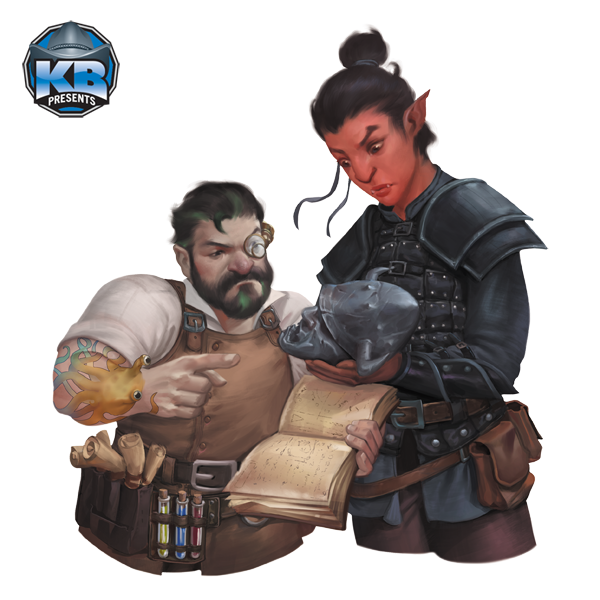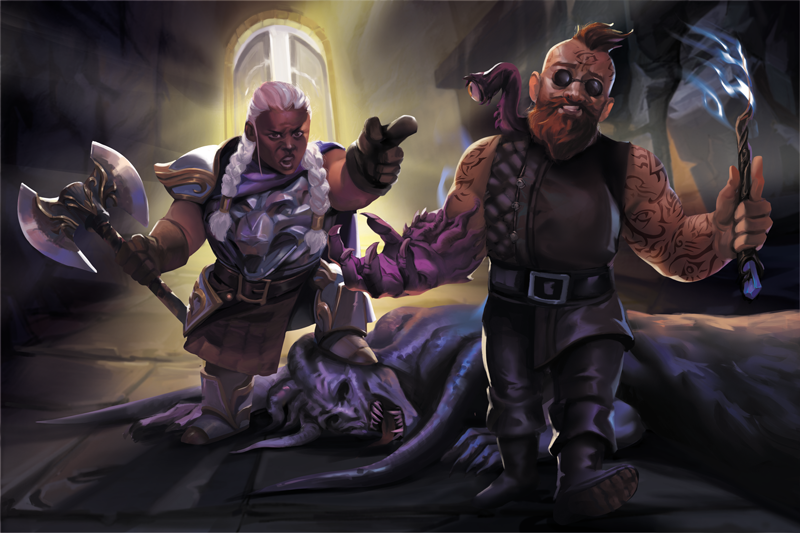
Every month, I ask my Patreon supporters for interesting questions about Eberron. This is the first time I’ve been asked about flumphs! So let’s get to it!
What’s the role of Flumphs in Eberron, especially in Riedra or Adar?
As far as I know, flumphs have never been addressed in canon. I’ve personally never used a flumph in any campaign I’ve run, so I’m primarily familiar with them from their appearances in Order of the Stick. So, the following things are true about flumphs in 5E.
- Flumphs are small aberrations.
- Flumphs are telepathic. They feed on telepathic emanations and thus are thus found around other telepathic species. They can eavesdrop on telepathic communication in their vicinity and cannot be perceived by telepathy or divination.
- Flumphs are wise and benevolent. They dislike holding on to evil thoughts, and thus when they overhear evil thoughts they will try and share them with good people—so they’re ideally suited to spilling the beans on illithid or aboleth schemes.
- They’re traditionally found in the Underdark, and live in harmonious units known as cloisters.
So with all that in mind, here’s how I’ll use flumphs in Eberron…
Flumphs are natives of Xoriat, where they dwell in the Emocean—a tide of surging thoughts and emotions, deeper and more primal than Dal Quor’s Ocean of Dreams. Flumph cloisters drift along streams of consciousness, drawing sustenance from the pure psychic emanations surrounding them. This is a blissful experience, and most flumphs have no interest in traveling to the material plane. But occasionally manifest zones form maelstroms within the Emocean, especially when people within the manifest zone suffer intense emotions. Flumphs in the material plane are fish out of water, and need to quickly find a source of psychic emanations in order to survive. While flumphs can draw sustenance from any form of telepathic emanation, they are benevolent by nature. While they can survive on a diet of cruelty, it’s distressing and they will seek to expunge the evil thoughts in a psychic exchange with good creatures whenever possible.
Flumphs enter Eberron through manifest zones to Xoriat. Here’s a few places flumphs can be found in Eberron.
- There are flumphs scattered across Sol Udar beneath the Mror Holds, pulled in by the fear and suffering of the dwarves battling Dyrrn the Corruptor. Most Mror flumphs are isolated and lost, struggling to survive. Sages of Clan Narathun have established a flumph sanctuary beneath Shadowspire and reunited a flumph cloister. A group of Narathun bards have been working with these flumphs to develop their thoughtsinging techniques, and flumphs are helping Narathun watch for Dyrrn’s forces.
- Flumphs can be found in the swamps of the Shadow Marches. Some linger in the periphery of dangerous telepathic entities. Others have formed a symbiotic relationship with a sect known as the Uul’gaanu, the “Daughters of the Dream.” A benevolent variation of Kyrzin’s Whisperers, the Uul’gaanu build their communities around hidden flumphs. The flumphs help the Uul’gaanu develop basic telepathic abilities; an Uul’gaanu community has a very simple hive mind, with members of the community casually sharing emotions and thoughts. Community members gather together for psychic metaconcerts, generating shared emotions that feed their flumphs. Dealing with the Uul’gaanu can be unsettling for outsiders, as the Uul’gaanu respond to the thoughts and emotions of their companions without need for speech; while for their part, the peaceful Uul’gaanu are often distressed by the cruel or selfish thoughts of outsiders. As a result, the Uul’gaanu tend to remain isolated from other Marcher communities.
- Flumphs have emerged in wild zones of Sarlona over the years. Because of their ability to eavesdrop on psychic communication, the Inspired consider them a security risk and exterminate them whenever they are found. However, a number of flumphs have found safe havens in the fortress monasteries of Adar. Adaran flumphs are valued members of their communities, engaging in thoughtsinging and presenting young Adarans with philosophical challenges. Some flumphs choose to work with Adaran security forces, watching for Inspired infiltrators and influences.
As denizens of Xoriat, flumphs perceive reality in very different ways from creatures of the material plane, and have different outlooks on the nature of time, space, matter, and individual identity. Those who can bend their brains to encompass these concepts can learn a great deal from flumphs, as shown by the nascent group mind of the Uul’gaanu and the thoughtsinging techniques of the Narathun. However, these concepts can be difficult to reconcile with everyday life in the material plane, and this can make conversations with flumphs confusing for people fully grounded in reality.
What is the Dreamspace, and how would you use it?
The Dreamspace is a concept introduced in Secrets of Sarlona, which has this to say:
Planar gateways that once linked Eberron and Dal Quor, the Region of Dreams, were sundered during the cataclysmic wars that destroyed Xen’drik and shattered the giant civilization. Since then, Dal Quor has been forever distant, and no stable manifest zones to Dal Quor exist anywhere on Eberron.
However, Dal Quor and Eberron remained inextricably linked by the state of dreaming—the process by which mortal minds travel to the Region of Dreams, and the subtle gateway through which the quori first began their conquest of Sarlona some fifteen centuries past.
Discovered short years ago and still known only to a few, the dreamspace is an effect that appears related to this spiritual connection between planes, but one that as yet has no explanation. It appears as a kind of ripple of arcane and psionic energy—a border of sorts between the mortal world and the world of dreams… Regardless of its origin, different factions among both the kalashtar and Inspired distrust—some even say fear—the dreamspace. In particular, a good number of Inspired are said to be disturbed by the existence of a power connected to Dal Quor that they neither control nor understand.
Secrets of Sarlona, Page 18
Secrets of Sarlona includes a set of “Dreamtouched Feats” that allow people to attune themselves to the Dreamspace. Specific uses include the Dream of Contact, which allows long-distance telepathic communication (not unlike Sending) and Dream of Insight, which allows the dreamer to make a Intelligence-based skill check with a substantial bonus to the role—essentially, drawing knowledge from the collective unconscious. These techniques are crucial tools for the Unchained, a resistance movement within Riedra whose members engage un unsanctioned free dreaming.
That’s the extent of canon information. The Dreamspace was “discovered a few short years ago” and both the Inspired and kalashtar distrust it. So what IS it? A few possibilities that come to mind…
- The Dreamspace is just part of the natural infrastructure of the planes. Think of it as the phone lines that connect mortal dreamers to Dal Quor. There’s nothing sinister about it; it’s just a (super)natural part of the world.
- The Dreamspace is an artifact created by the quori of a previous age when they interacted with Eberron. Rather than tying this to the Giant-Quori conflict in Xen’drik, I’d tie this to an even older age of Dal Quor, potentially associated with long-forgotten civilizations in either Khorvaire or Sarlona… civilizations destroyed by the rising of the Daughter of Khyber or another Overlord. This allows for the discovery of ancient rituals or artifacts designed to manipulate the Dreamspace, and leaves the question open as to whether the quori of that past age were benevolent or if the Dreamspace itself was designed as some sort of weapon or tool of oppression.
- People have only discovered the Dreamspace recently because it’s only recently come into existence. It’s the side effect of unforeseen damage the Inspired are inflicting on the psychosphere of Eberron through their use of the hanbalani monoliths. At the moment it’s a useful tool, but as the damage becomes more extensive it could connect unwilling minds, cause dreaming spirits to be lost in the Dreamspace instead of reaching Dal Quor, or far worse things.
- The Dreamspace is a hoax. It’s a creation of the Dreaming Dark, a lure that’s being used to draw out rebels like the Unchained. Attuning the the Dreamspace and developing Dreamtouched techniques actually makes the user more vulnerable to quori possession.
These are all interesting possibilities. The point is that, like the Mourning, I wouldn’t WANT to present a single kanon or canon answer, because a central point of the Dreamspace is that the people using it don’t know what it is. It is a new tool that’s being latched onto by a desperate resistance—is it a blessing, or could it be a trap? Is it secretly a tool of the Dreaming Dark, or is it a the horrifying result of their messing with powers beyond even their control? Each of the four options above would form the foundation of very different stories. Using the first option, it could be a simple, reliable tool that has no other significant impact on the story. Using the second option could unveil a quori scheme from a previous age that dwarfs the ambitions of the Dreaming Dark—while the third option could end with the Dreaming Dark and the player characters working together to disassemble the hanbalani system before it tears reality apart.
So, the Dreamspace was always intended to be an idea that each DM could use in different ways; perhaps one of these ideas will inspire you!
That’s all for now! Thanks again to my Patreon supporters for posing interesting questions and for making these articles possible!

 Unlock with Patreon
Unlock with Patreon
